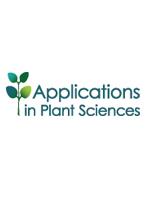Leptospermum recurvum Hook. f. (Myrtaceae) is a woody species distributed from 2700 to 4000 m on Mount Kinabalu in Borneo. This species has a wide habitat range from deep soils to denuded rocks, and varies in life form from a tree to a dwarf shrub to a cushion plant. All forms have continuous phenotypic polymorphisms with regard to leaf traits. These phenotypes often occur in the same place, but the composition of phenotypes varies among habitats. Elucidating the genetic structure and patterns of gene flow across phenotypes and habitats is the first step to understanding the evolutionary process behind this phenotypic differentiation. Lee and Lowry (1980) conducted an allozyme analysis, but they detected few polymorphisms among the five populations present in the distribution range despite large phenotypic variations. In such a situation, highly polymorphic simple sequence repeat (SSR) markers are required to determine genetic characteristics. Here, we present 10 polymorphic and one monomorphic SSR markers of L. recurvum and also describe successful amplification of the related species L. polygalifolium Salisb.
METHODS AND RESULTS
Prior to development of the markers, we collected seeds of L. recurvum from a population located at an elevation of 3300 m on Mount Kinabalu (6.05824°N, 116.56566°E) and cultivated the seedlings in our laboratory. Fresh leaves were sampled from one of the seedlings for DNA extraction to construct an SSR library. The voucher specimen of this seedling was deposited in the Sabah Parks Herbarium at Kinabalu Park headquarters (KIN accession no. SNP28526). We developed SSR markers using an improved technique for compound SSR markers (Lian et al., 2006; Araki et al., 2011). An adapter-ligated DNA library was constructed as described previously (Lian et al., 2001). The fragments were amplified from an EcoRV (TaKaRa Biotechnology Co., Otsu, Japan) DNA library using an adapter primer, AP2 (5′-CTATAGGGCACGCGTGGT-3′), and a compound SSR primer, (AC)6(AG)7 or (AC)6(TC)7. The amplified fragments of 400–1000 bp were purified using a QIAquick Gel Extraction Kit (QIAGEN, Valencia, California, USA) and cloned using a QIAGEN PCR Cloningplus Kit (QIAGEN) in accordance with the manufacturer's instructions. A total of 224 insert-positive clones were sequenced. We identified 33 distinct sequences containing an (AC)6(AG)n or (AC)6(TC)n compound SSR sequence at one end using ClustalX version 2.1 (Larkin et al., 2007). Based on these 33 sequences, specific primers were designed using Primer3 version 0.4.0 (Rozen and Skaletsky, 2000).
PCR amplifications were performed in a final volume of 5 µL using a QIAGEN Multiplex PCR Kit (QIAGEN) according to the standard protocol with a GeneAmp PCR System 2700 thermal cycler (Applied Biosystems, Carlsbad, California, USA). The combination of multiplex reactions is shown in Table 1. Compound SSR primers were labeled with fluorochromes, as shown in Table 1. PCR amplifications were performed under different cycling conditions based on the compound SSR primers: for the primers labeled with VIC or 6-FAM, initial denaturation was performed at 95°C for 15 min followed by 25 cycles of denaturation at 94°C for 30 s, annealing at 57°C for 1 min 30 s, extension at 72°C for 1 min, and a final extension at 60°C for 30 min; for the primers labeled with PET, the number of cycles was increased to 33, but the other conditions were unchanged. Size of the PCR products was determined using an ABI PRISM 3100 Genetic Analyzer (Applied Biosystems) and Genotyper software (Applied Biosystems) with GeneScan 500 LIZ (Applied Biosystems) as an internal size standard. Although the reliability and repeatability of compound SSR primers are controversial, we conducted repeated amplification of eight identical samples and obtained consistent results using the markers described here.
Eight individuals from the population located at 3300 m (GPS coordinates are shown in Table 2) were used in initial screening of the 33 primer pairs designed here. Of these 33 primer pairs, 11 exhibited clearly identifiable bands (Table 1). We tested the characteristics of each locus with these 11 primer pairs using samples from four populations: three L. recurvum populations with various phenotypes from different habitats ranging from the lowest altitude (2700 m, forest), middle altitudes (3300 m, shrub), to the highest altitude (3900 m, alpine cushion community) on Mount Kinabalu, and one L. polygalifolium population found at 1900 m on Mount Kinabalu. Because the locus Lrec401 was monomorphic in all populations, this locus was excluded from the subsequent analyses. We found that all loci had more than one allele except for the locus Lrec139 in the L. recurvum population at the lowest altitude. Using GenAlEx version 6.3 (Peakall and Smouse, 2006), the observed heterozygosity, expected heterozygosity, and inbreeding coefficient values of L. recurvum were found to range from 0.04 to 0.94, from 0.04 to 0.83, and from −0.48 to 0.42 (except for the monomorphic locus Lrec139), respectively, and those for L. polygalifolium ranged from 0.07 to 0.67, from 0.29 to 0.84, and from −0.18 to 0.84, respectively. We also tested for departure from Hardy–Weinberg equilibrium (HWE) for all populations and loci as well as for linkage disequilibrium (LD) between all pairs of polymorphic loci using FSTAT version 2.3.9.2 (Goudet, 1995, 2001). We found that no population demonstrated significant departure from HWE, and that no pair of loci exhibited significant LD (P < 0.05 after Bonferroni correction).
TABLE 1.
Characteristics of the 11 SSR loci isolated from Leptospermum recurvum.

CONCLUSIONS
The 10 primer pairs developed in this study successfully amplified the SSR loci of all three populations of L. recurvum, which include those from different habitats and of various phenotypes. These primer pairs will be useful for investigating patterns of gene flow and genetic structure of L. recurvum across habitats and phenotypes. In addition, our markers successfully amplified the loci of and detected polymorphisms in the related species L. polygalifolium; these markers are expected to have broader application.
TABLE 2.
Summary statistics of 10 SSR loci in three populations of Leptospermum recurvum and one population of L. polygalifolium.a, b






